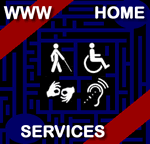Effective Navigation Tips
 We are committed to ensuring that this website is accessible to all users by conforming to existing recommendations and standards. If you encounter a problem accessing this site or if you would like to provide feedback, please contact us. We strive to make our information accessible to all individuals, including individuals who use assistive technology to access this website and individuals who log in from slow connections. This website was designed to accommodate individuals with cognitive, motor, and sensory limitations.
We are committed to ensuring that this website is accessible to all users by conforming to existing recommendations and standards. If you encounter a problem accessing this site or if you would like to provide feedback, please contact us. We strive to make our information accessible to all individuals, including individuals who use assistive technology to access this website and individuals who log in from slow connections. This website was designed to accommodate individuals with cognitive, motor, and sensory limitations.
We refrain from using pop-up menus, unformatted PDF files, timed settings, or animated GIFs. A brief alt-attribute tag that identifies the image or its function accompanies all essential images on this site. Parts of website use JavaScript but the mouse is not required for activation and content and navigation are available even if scripting has been disabled in the browser. The use of layout tables has been minimized. However, the page content should be readable where they exist, even when the page is linearized.
This website has been tested for use with assistive technology such as screen readers, keyboard controls, and alternative input devices. In addition, our website has been tested for use with several browsers, including Netscape Navigator, Internet Explorer, Opera, and text equivalents.
We are committed to eliminating barriers to information and access to the Internet. Our webmaster has attempted to design pages with low bandwidth with minimal dependence plug-ins. In the rare case that a plug-in may be required, a link will be provided to download a free version of the plug-in.
Our Web designer looks to the Web Accessibility Initiative (WAI) Guidelines and Section 508 Standards of the amended Rehabilitation Act for guidance on design.
This web site conveys information clearly to its intended audience (visitors and potential customers who may or may not be individuals with one or more types of disabilities).
- Uses language in a way that is familiar to and comfortable for its readers.
- Is conversational in its tone whenever possible.
- Uploads within a reasonable amount of time, even on a slow dial-in connection.
- Is accessible to readers with physical impairments.
- Provides an easily discoverable means of communicating with the author or administrator.
- Offers a consistent, clearly recognizable "look and feel".
- Makes effective use of repeating visual themes to unify the site.
- Is visually consistent even when graphics are turned off.
- Uses (approximately) standard link colors whenever possible.
- Creates links which are obvious in their intent and destination.
- Provides a convenient, obvious way to maneuver among related pages and different sections.
- Makes effective use of hyperlinks to tie related items together.
- Has no dead links, broken CGI scripts, or functionless forms.
- Creates a page length that is appropriate to the site content.
- Is moderate in its use of color.
- Avoids juxtaposing text and animations.
- Requests user feedback whenever possible.
This website has undergone consistent checks for validation and meets Section 508 Standards and W3C Guidelines. If you experience difficulty accessing the information on this Web site, please notify the Web Master.
